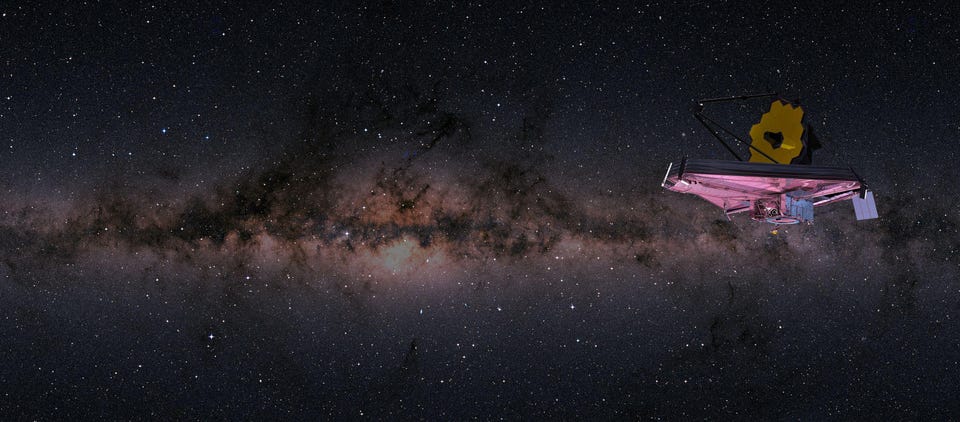For those of us who waited with bated breath to see the first images from the James Webb Space Telescope (JWST), the wait was well worth it. In profoundly beautiful color and detail, these first images of the world’s largest and most powerful space telescope are only the first glimpses at what lies ahead in the coming years. To literally watch the other side of the universe as it was forming over 13 billion years ago is a mind bender.
Given the uncanny symmetry that seems to organize all of what we are observing, we can reasonably assume our own solar system formed in the same way. In a sense, we now have photographic proof – a selfie of sorts – to go along with the immortal words “…without form, and void. ” (Genesis 1:2) Of course, the fiscal hawks are already screaming about the cost – $10B.
That is a lot, but not when considering how much we will advance human civilization with new understandings of the universe. For less than 1% of a Mars mission , the recurring scientific advances coming from the Webb telescope will last for 15 years, probably 40 if its predecessor, Hubble, is any indication . For JWST, the taxpayer did put a lot of proverbial eggs in a single basket, but with painstaking discipline and caution, NASA proved it can still achieve eyewatering advances for all mankind.
And by advancing a purely scientific mission, no fear is induced because there is no perceived rise in military power. On the contrary, it is enhancing diplomacy by sharing data and broadening our collective understanding, unifying the world. The biggest lesson from JWST’s success is how affordably we can advance our understanding of the planets, our galaxy, and even the universe without the extreme danger or astronomical (pardon the pun) expense of sending humans into space.
At a time when government budgets are very limited in even their ability to service debt obligations and pay for minimum essential services, satellites and roaming robots are the answer. After the JWST, what else can be done in space to advance NASA science in lieu of a government directed program to Mars? The answer is closer to home – that precious planet third from the sun, its surface covered in liquid water, and full of life. Observing our celestial home from space would help us to scientifically understand, appreciate, and lead it to a better sanctuary for all who live on it.
As much as we think we understand our Earth, we still know surprisingly little about it. To better unlock the answers to our changing climate, what causes it, and how we should adapt, the various collections of space data have already begun to reveal a wealth of information, but we have only begun to scratch the surface. For example, weather prediction, both terrestrial and the storms that come from our own sun, has become more and more vitally important as our society grows more complex and interdependent.
Predicting events originating within the Earth, such as seismic activity and the rise and fall of aquifers can also be greatly enhanced by incorporating satellite measurements into predictive models. Finally, understanding the ecological impacts of deforestation and desertification will help us solve these problems by improving our climate and weather models. Much like JWST, all this scientific understanding and much more can be achieved with satellites and robots, without risking human lives or further enslaving future generations with debt.
Robotic devices of all types have proven themselves to be faster and dramatically less expensive than humans – and with much more endurance. They can enable us to quickly advance our understanding of the science of our solar system, how it was formed, and the threats to civilization from it. These unmanned sentinels can serve as dramatically lower and non-threatening way to inform the community of nations while fostering a renewed sense of human connection, dispensing with paranoia too often rooted in superstition or historical transgressions.
Finally, since the focus will be on collecting materials and new data, NASA will be better able to leverage and promote the new century’s information economy, not just extend the rocket scientist legacy of the last one. Let me be clear, there is nothing wrong with manned space programs. But the time has come to vacate the driver’s seat and move over to the passenger’s side in the American human spaceflight journey.
NASA must formally pass the leadership baton to commercial companies and the hundreds of suppliers and partners backed by billionaires and other investors and empower them to lead the way. Companies like SpaceX, Blue Origin, Sierra Space, and Virgin Galactic are already paving a route forward for themselves and others in a drastically more efficient manner. NASA must complete this effort, initially spearheaded by Lori Garver and her team during the Obama administration .
If we can successfully pivot the rest of human spaceflight activities –including future trips to the Moon and to Mars – towards procuring commercial services as requested and funded by a Congress elected by the people, we will cement a self-sustaining US presence in space at a pace competitive to our adversaries. In the last century, the US led the world’s aviation sector precisely because the government did not try to micromanage its design. It was highly regulated, of course, but it was promoted by a commitment to buy commercial products and services instead of the government attempting to compete against commercial industry.
Our government’s 60-year investment in human spaceflight was not a wasted venture. We won that space race as part of a Cold War strategy: we could demonstrate space supremacy without bloodshed. But this century’s space contest is about values, chief among them the freedom to explore and understand.
Let’s advance science, emboldened by the grand images of our universe beyond our field of view, to build a better world and grow a real commercial space economy. .
From: forbes
URL: https://www.forbes.com/sites/charlesbeames/2022/08/11/the-biggest-lesson-from-james-webb-that-no-one-is-talking-about/
